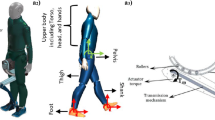Abstract
An explicit equation of motion for constrained systems, called the Udwadia-Kalaba equation, opens up a new way of dynamic modeling of constrained multibody systems, which is accomplished in a straightforward and novel three-step process. However, constraint violation arises from violation of the lower-order constraint equations because the aforementioned equations incorporate only the acceleration level constraints. There are two methods, Baumgarte stabilization method (BSM) and modified method, are implemented to realize the constraint violation suppression. The comparison of the BSM and the modified method is provided, based on numerical simulations for a sample constrained system that represents a lower limbs rehabilitative robot with continuous passive motion for therapy and rehabilitation. The results of numerical simulation obtained by the modified method are superior to that obtained by BSM, which confirms the numerical effectiveness and accuracy of the explicit solution based on the modified method to the constrained planar multibody systems.
Similar content being viewed by others
References
S. Rahmatalla, E. T. Lee and H. C. Eun, Numerical integration scheme to reduce the errors in the satisfaction of constrained dynamic equation, Journal of Mechanical Science and Technology, 27 (4) (2013) 941–949.
H. Zhao, S. C. Zhen and Y. H. Chen, Dynamic modeling and simulation of multi-body systems using the Udwadia-Kalaba theory, Chinese Journal of Mechanical Engineering, 26 (5) (2013) 839–850.
D. J. Braun and M. Goldfarb, Eliminating constraint drift in the numerical simulation of constrained dynamical systems, Computer Methods in Applied Mechanics and Engineering, 198 (37) (2009) 3151–3160.
D. L. Pan, F. Gao and Y. J. Miao, Dynamic research and analyses of a novel exoskeleton walking with humanoid gaits, Proceedings of the Institution of Mechanical Engineers, Part C: Journal of Mechanical Engineering Science, 228 (9) (2014) 1501–1511.
M. H. Korayem and A. M. Shafei, A new approach for dynamic modeling of n-viscoelastic-link robotic manipulators mounted on a mobile base, Nonlinear Dynamics, 79 (4) (2015) 2767–2786.
F. E. Udwadia and R. E. Kalaba, A new perspective on constrained motion, Proceedings: Mathematical and Physical Sciences (1992) 407–410.
A. D. Schutte and F. E. Udwadia, New approach to the modeling of complex multibody dynamical systems, Journal of Applied Mechanics, 78 (2) (2011) 856–875.
F. E. Udwadia and R. E. Kalaba, Analytical dynamics: A new approach, Cambridge University Press, Cambridge (1996).
F. E. Udwadia and R. E. Kalaba, On the foundations of analytical dynamics, International Journal of Non-linear Mechanics, 37(6) (2002) 1079–1090.
F. E. Udwadia and R. E. Kalaba, What is the general form of the explicit equations of motion for constrained mechanical systems, Journal of Applied Mechanics, 69 (3) (2002) 335–339.
W. Blajer, Methods for constraint violation suppression in the numerical simulation of constrained multibody systems-A comparative study, Computer Methods in Applied Mechanics and Engineering, 200 (13) (2011) 1568–1576.
J. Baumgarte, Stabilization of constraints and integrals of motion in dynamical systems, Computer Methods in Applied Mechanics and Engineering, 1 (1) (1972) 1–16.
C. W. Gear, B. Leimkuhler and G. K. Gupta, Automatic integration of Euler-Lagrange equations with constraints, Journal of Computational and Applied Mathematics, 12 (1985) 77–90.
W. Blajer, Elimination of constraint violation and accuracy aspects in numerical simulation of multibody systems, Multibody Syst. Dynam, 7 (2002) 265–284.
Y. K. Kim et al., Effects of walking speed and age on the directional stride regularity and gait variability in treadmill walking, Journal of Mechanical Science and Technology, 30 (6) (2016) 2899–2906.
E. Akdogan and M. A. Adli, The design and control of a therapeutic exercise robot for lower limb rehabilitation: Physiotherabot, Mechatronics, 21 (3) (2011) 509–522.
R. Q. Lu et al., Development and learning control of a human limb with a rehabilitation exoskeleton, IEEE Trans Ind Electron, 61 (7) (2014) 3776–3785.
W. Blajer, K. Dziewiecki and Z. Mazur, An improved inverse dynamics formulation for estimation of external and internal loads during human sagittal plane movements, Computer Methods in Biomechanics & Biomedical Engineering, 18 (4) (2015) 362–375.
F. E. Udwadia, Equations of motion for constrained multibody systems and their control, Journal of Optimization Theory and Applications, 127 (3) (2005) 627–638.
P. Shenoy et al., Online electromyographic control of a robotic prosthesis, IEEE Transactions on Biomedical Engineering, 55 (3) (2008) 1128–1135.
Author information
Authors and Affiliations
Corresponding author
Additional information
Recommended by Associate Editor Kyoungchul Kong
Yaru Xu is currently a Ph.D. candidate in the School of Mechanical Engineering and Automation at Beihang University, China. Her research interests are in the area of multibody dynamics and rehabilitative robots.
Rong Liu received his Ph.D. in the School of Mechanical Engineering and Automation from Beihang University, China, in 1996. He is currently a Professor of School of Mechanical Engineering and Automation, Beihang University. His main subjects are multibody dynamics, robotics and MEMS.
Rights and permissions
About this article
Cite this article
Xu, Y., Liu, R. Dynamic modeling of constrained planar multibody systems: A case of lower limbs rehabilitative robot. J Mech Sci Technol 32, 3389–3394 (2018). https://doi.org/10.1007/s12206-018-0642-6
Received:
Revised:
Accepted:
Published:
Issue Date:
DOI: https://doi.org/10.1007/s12206-018-0642-6



